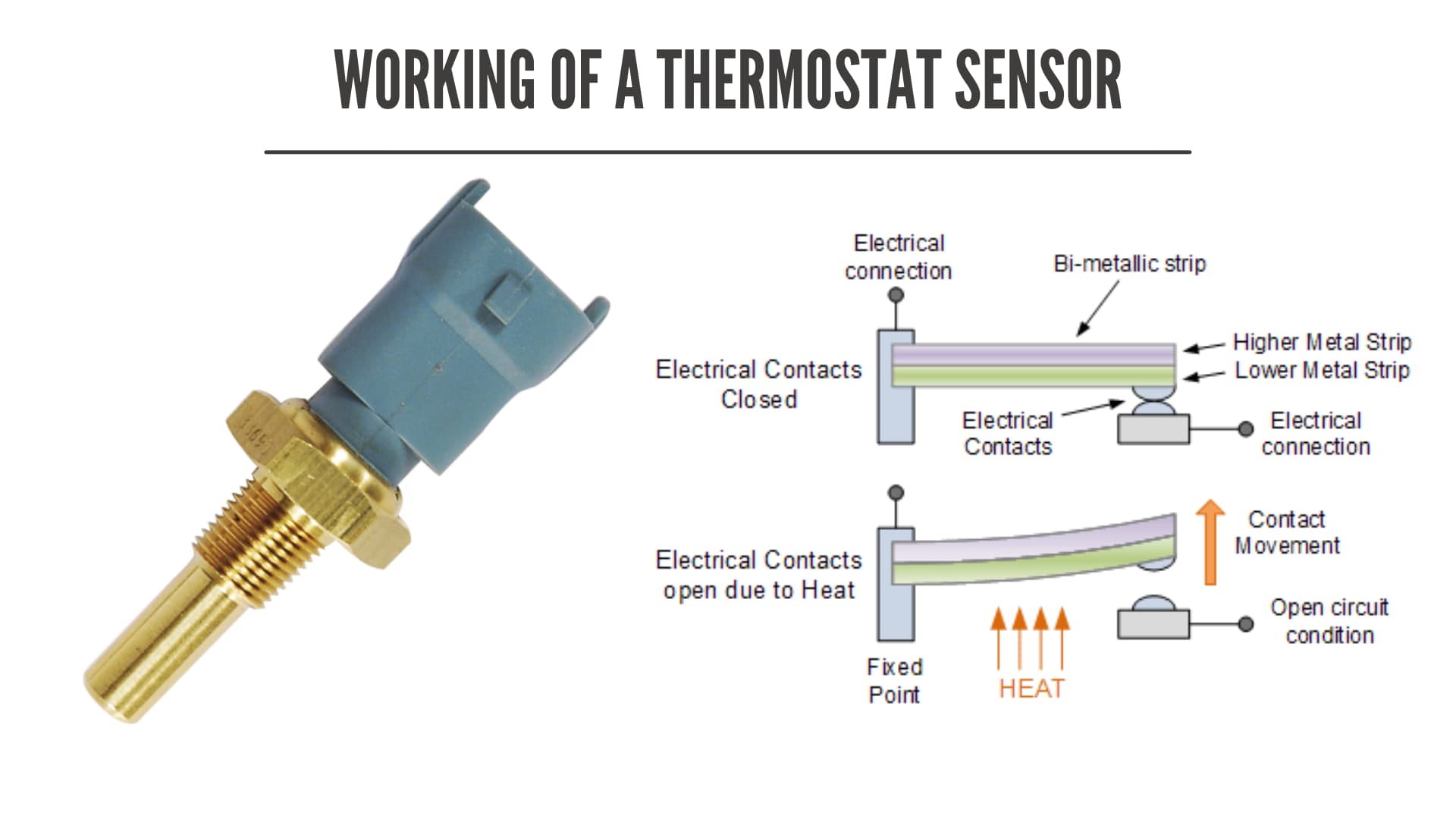First, let me tell you why this question is so important and relevant.
Because when talking in terms of electronics the word thermostat can mean one thing and in terms of modern gadgets, the term may mean a completely different thing.
In the light of that understanding, the question can be answered in two routes.
One from the context of practical electronics and the other from the context of smart gadgets.
Because in technological terms a thermostat may either mean a temperature sensor or a full-fledged smart temperature control and monitoring mechanism. Keeping this understanding in mind,
Is Thermostat Digital or Analog?
A thermostat temperature sensor is not an analog sensor as it doesn’t produce an output signal that continuously changes its value with respect to time. Thermostat smart gadgets on the other hand can be both analog and digital.
So, you see, not having the clarity on the context over which the word thermostat is used can create some confusion.
I have created the article in such a way that by the end of it you would have had sufficient knowledge to demarcate the differences between the two.
You will know in what context the discussion is underway in any forum or maybe in your class and you can partake in the discussion in the right frame.
And by the way, this isn’t the only article that I have done on thermostats.
Here are a few more topics on thermostats that will append what you will learn here nicely.
- Is thermostat a sensor?
- 7 best thermostats that work with alexa
- Do smart thermostats work without wifi?
- Do Arduino sensors work with raspberry pi?
- 7 best ring compaticle thermostats
What is a Thermostat Sensor?
A sensor is a device that as the name suggests senses a physical parameter and generates a proportional signal as an output which can then be processed to estimate the value of the physical parameter.
There is no shortage of physical parameters in the world. There is temperature, pressure, motion, humidity, acceleration, orientation, etc., and depending on the parameter sensor types vary.
When it comes to temperature for instance, because the range of temperature varies from extreme cold to extreme hot, you require different types of sensors for different temperature ranges.
In one of my previous topics around sensors, I discussed different types of temperature sensors.
Out of the varied options, a very commonly used temperature sensor is what is known as the thermostat.
You see, I am using the word sensor for thermostat very reluctantly because for the most part of it a thermostat is nothing but a thermostatic switch.
So, so many times I get the question, is thermostat an analog sensor?
Well, at best you can call a thermostat a sensor switch because it doesn’t fit the definition of an analog sensor which is a sensing unit that produces a continuous time-varying signal at the output.
Yes, it does sense the temperature of the ecosystem it is a part of. And when the temperature reaches a certain limit it either cuts off a circuit or in some cases completes a circuit just like a circuit switch.
This diagram helps explain how the sensor works.

Within a thermostat is a bimetallic strip that is formed of metals with different temperature coefficients.
So, when subjected to elevated temperature, the two metals expand at a different rate (because of different temperature coefficients) thereby creating a resultant bend/arc which can be used to complete or break a circuit.
What Is a Smart Thermostat?
The word thermostat in technological terms may also imply an intelligent temperature control mechanism.
The function of a thermostat (or a smart thermostat) is to maintain the room temperature at a defined temperature value.
Now thermostats aren’t new devices, they have been part of our homes for a while now.
However, with the advancement of core hardware technology and cloud support, these simple devices are now enhanced to work in a better way.
And thus, are called smart gadgets or smart devices.
Having a bunch of these in your homes, functioning and interacting with each other will convert it into what you can refer to as a smart home.
So, what exactly are smart thermostats and how do they work?
A smart thermostat is an advanced temperature control and monitoring mechanism that you can control via smart devices. You can set temperature with a dedicated app, give voice commands, control energy usage, and even set it to turn on and off on the basis of your everyday behavior.
Smart thermostats are one of the top gadgets one chooses in his or her journey towards home automation.
Not the cheapest of options but a very worthy addition to your cluster of smart gadgets.
The operation of smart thermostats just like any other smart gadget revolves around a cloud that enables them to communicate, update, and share data in the smart ecosystem.
The incorporation of advanced hardware and software capabilities renders these thermostats much more efficient, accessible, and user-friendly.
Unlike simple thermostats, smart thermostats will let you manage the temperature of your home using an app on your favorite device.
The chain of operation involves your heating system’s boiler, thermostat control, and the app. With this app, you will be able to control and adjust the temperature even if you are not at home.
Some latest thermostats are also Alexa, Ring, and Google Assistant compatible, which means you can make all of the thermostat functions happen using your voice.
Disadvantages of Analog Thermostats
I am pretty sure I don’t need to tell you this but we are living in a digital age.
What this means is everything is getting smaller and everything is getting efficient.
What a few years back we wrote on stone(inscriptions), it feels we are writing so much more in the air.
So, this shift to smart thermostats, has happened out of the limitations of Analog thermostats, or is this just a natural technological progression?
It’s a bit of both actually. Here are the inherent disadvantages of Analog thermostats.
- Limited Functionality
Most Analog thermostats are simple to operate yes, but their range of operations and their functionality are limited.
They will do a good task of doing what they are supposed to do yes, but in today’s world where every gadget can multitask and communicate with other devices in an ecosystem,
In most cases, you will have to manually set it up, and whenever you wish to change the ambient temperature someone has to set it again using a dial.
- Accuracy
While they do tend to do the job they intend to do, most Analog thermostat users complain of them becoming less accurate with time.
Analog thermostats (the really old ones) use mercury for displays. They are hard to read and they are usually installed on old HVAC systems and thus contribute to the lack of accuracy.
- No Remote Control
Some thermostats that aren’t that old actually come with remote control. But their range is limited and they can’t be termed smart thermostats.
Smart thermostats can be controlled with an app from anywhere. All you need to ensure is that your gadget is in Wi-Fi range and gets uninterrupted data which is pretty much given in this day and age.
- Lack of Automation
Of course, old Analog thermostats are like a fixed entity. They do what they do and you can’t expect them to do more.
While there is a simplicity about that and some may even like keeping things retro, the fact that you have to do everything manually today or tomorrow will get to your nerves.
- Limited to No Compatibility
One incredible feature that smart devices today feature is their compatibility with other devices in what is called a smart ecosystem.
That is what this Internet of Things is all about.
A while ago I created an article where I listed top ring compatible thermostats. Well, you can expect something like that from analog thermostats.
Advantages of Digital Thermostats
- Precision
First things first, owing to the hardware design and superior software technology these devices are insanely accurate.
Unlike Analog thermostats that use mercury, they use a digital backlit display that allows easy reading and temperature setting.
Most modern smart thermostats work with new HVAC systems and the combination ensures precision even more.
- Energy Conservation
This is a big topic of discussion among enthusiasts and most agree with the smart features digital thermostats come with, they help optimize energy use.
That is one big selling point with these thermostats and gadgets in general as people feel they are contributing to eco-friendliness in a small yet significant way.
- Communication
Most smart devices are able to communicate and share data with each other over cloud.
And as technology is progressing, manufacturers are slowly becoming okay with sharing their device data with devices from other manufacturers given that they belong to the same house/ecosystem.
This helps increase the overall effectiveness of these devices as they can now perform as a single unit albeit performing different functions.
- Artificial Intelligence
AI is getting infused everywhere. Thermostats are no exception.
Advanced thermostats can now log what kind of energy usage they are partaking in, and with sufficient data, can modulate themselves such that they can either elevate performance or optimize energy use depending on your usage patterns.
Similarly understanding patterns of use thermostats can identify at what times you are home and can switch themselves on or off, thereby saving energy and your effort.
- Voice Control
This is becoming a very sought feature in thermostats. Most smart thermostats are Alexa, Google Assistant capable which means you can control them using your voice.
This feature is still very much a work in progress but the results have been exceptional.
Can you Replace an Analog Thermostat with Digital?
This is a very important question that I think I can address at this juncture. I have received this question countless times.
So, can you actually replace an analog thermostat with a digital one?
Yes, in most cases, you should easily be able to replace an analog thermostat with a digital one. First, turn off the main power, take off the front panel, and note which wires go where in your analog thermostat. Connect the wires to the same contacts on the digital thermostat after you fasten it to the wall and you are done.
When replacing an analog thermostat with a digital one your best friends would be the manual of both the thermostats.
While in most cases, if you just connect the wires in the same terminals of the digital thermostat as was the case with an analog thermostat, you will be fine.
What this means is the wire that went into the G terminal of the thermostat will go into the G terminal of the digital thermostat.
Similarly, if you took a wire out of the Y terminal put the wire into the Y terminal of the digital thermostat.
If you continue on like this, you should be able to complete the connections and have your digital thermostat up and running in no time.
Given the context of the article, I am not going in-depth into the entire procedure of replacing an analog thermostat with a digital one.
If you want just let me know in the comments section below, and I will create a comprehensive guide on installing digital thermostats.
I will take a few thermostat connection samples from different manufacturers and create a guide that will be applicable to thermostat installations in a generic sense.
Doing so in this article itself will render the write-up annoyingly large for you.
And I like to keep knowledge bytes chewable size if you know what I mean.
I hope you enjoyed the article and the topic as much as I did.
If you have any queries regarding thermostats or anything about which I write here on Yantraas, do let me know in the comments section as well.
Take great care of yourselves and I will see you in the next one!
Bye Bye!




Hey Dear, Your content is so amazing. After reading this one question is clear in my head about Replacement an Analog Thermostat with Digital. Thanks for sharing this…
Glad I could help Shivam!